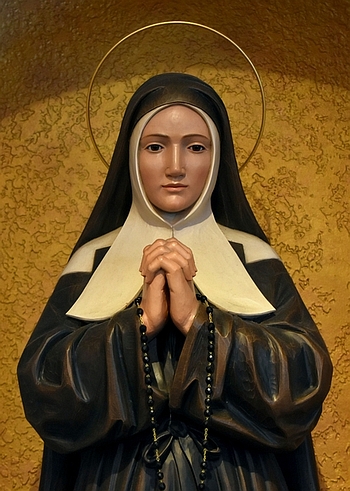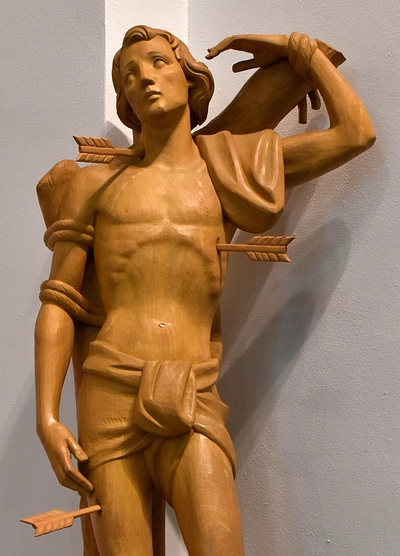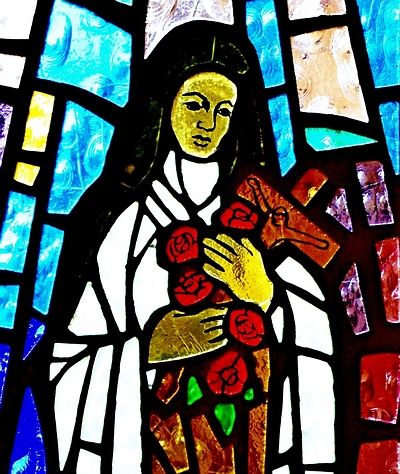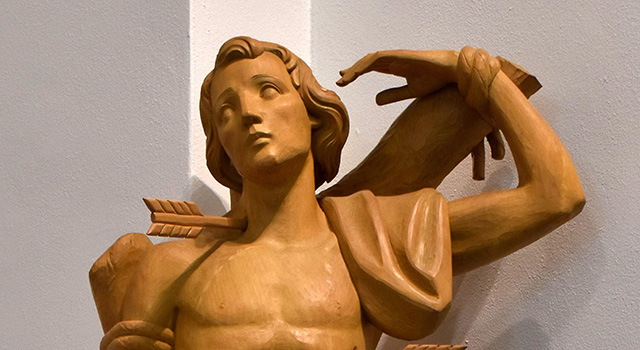By Catholic News Service - Catholic News Service
WASHINGTON (CNS) | The Catholic Church has a long tradition of calling on saints and praying for their intercession in sickness and difficult times.
At least 100 saints can be invoked for protection or healing of nearly every possible ailment from eye troubles, headaches and toothaches to cancer, rabies and epilepsy.
When asked about saints who would be good intercessors during the coronavirus pandemic, Jesuit Father James Martin, editor at large at America magazine, told CNS that three saints he mentions in his 2006 book My Life With the Saints would be good to start with.

Photographer: Jim Davis
Statuette depicts St. Bernadette at Our Lady of Lourdes Church, Miami.
At the top of his list is St. Aloysius Gonzaga, the Jesuit saint who died as a result of working with victims of a plague in Rome. The second is St. Therese of Lisieux, “who also had to deal with illness at a young age.”
Last on his shortlist is St. Bernadette Soubirous, the visionary of Lourdes, France, who contracted cholera in the epidemic of 1854. Bernadette also suffered from asthma and other ailments throughout her life. She is invoked as a patron for the millions who go to Lourdes each year seeking healing.
Father Martin said that when he was undergoing treatment for a benign tumor and radiation last summer, he prayed to St. Bernadette and Our Lady of Lourdes.
This plea for saintly help for healing and protection was particularly clear when the bubonic plague, or Black Death, spread throughout Europe in the 14th century killing one-third of the population. At the time, in many cities and villages where medical knowledge was limited, cities and villages often adopted a plague saint to protect them.
In Florence, Italy, the bishop had an altar built in honor of St. Sebastian as a means to stop the Black Death. After the plague was over, he built a church dedicated to the saint in gratitude. Artwork depicting the plague shows that St. Sebastian seemed to be the go-to saint at the time.
He was martyred around the year 288 during the reign of the Roman emperor Diocletian. He was shot by arrows, which is how he is portrayed in paintings. The arrows are also said to symbolize the Black Death.
But the special appeal of St. Sebastian has a lot of layers. He is said to have converted to Christianity after seeing the bravery of Christian martyrs. He then drew others to become Christian, including a Roman officer who was said to be have been cured of a plague at his conversion.

Photographer: Jim Davis
St. Sebastian stands at the chancel of his namesake church in Fort Lauderdale.
This action caught the attention of Diocletian, who sentenced Sebastian to death. But the saint, according to tradition, survived the arrows and returned to Diocletian to denounce him. The emperor again, and successfully this time, had Sebastian executed.
Sebastian's prayers for the Roman soldier made him associated with the cure of plagues, especially in Italy.
St. Roch also is portrayed in paintings of the plague, but he is shown among victims, often praying to Mary, since he too died from the disease. The same holds true for St. Aloysius Gonzaga, who contracted a different plague, which hit Rome in 1591, and died of it while caring for victims.
There's also a whole group of saints who were called on for prayers during the plague, starting in 1348 in Munich. This group goes by the name the Fourteen Holy Helpers.
The group of 14 — each with individual feast days, and one day for the whole group until 1969 — is honored in a German chapel that is a pilgrimage site. Churches in Italy, Austria, Hungary and other European countries are named after these 14, as is a parish in West Seneca, New York.
Twelve of this specialized group are martyrs, and three are women. Perhaps most known now among the group is St. Blaise, patron saint of throats, who is invoked each Feb. 3 on his feast day.
The other 13 saints have their own specialties. They include Achatius, headaches; Barbara, fever or sudden death; Catherine of Alexandria, sudden death; Christopher, plagues, sudden death; Cyriacus (Cyriac), temptations; Denis (Dionysius), headaches.
Also, Erasmus (Elmo), abdominal maladies; Eustachius (Eustace), family trouble; George, protection of domestic animals; Giles (Aegidius), plagues, good confession; Margaret of Antioch, safe childbirth; Pantaleone, physicians; St. Vitus (St. Guy), epilepsy.

Photographer: Jim Davis
St. Therese de Lisieux holds roses and a crucifix in this window at St. Maurice Church, Dania Beach.
Today, Fourteen Holy Helpers Parish in New York, looks on its website like most U.S. parishes. But the full monthly calendar has the word "canceled" after every scheduled event.
“This period of time when we have been required to cancel public Masses and all parish events and services should certainly be considered one of the most difficult periods in the 156-year history of our parish,” a parish announcement says. “Even through this time of decreased activity, a number of expenses continue to be incurred … utilities, insurance, maintenance, and payrolls to name a few."
During this current time of coronavirus pandemic, some have called on St. Corona as a possible patron, but the connection seems to be in name only. A Catholic News Service article says that little is known about the young woman who was killed for her faith, presumably in the second century A.D.
St. Corona also is not the namesake for the virus. The Latin word “corona” means “crown,” an indication that the young saint had achieved the “crown of eternal life” because of the steadfastness of her faith. The connection with the coronaviruses, named because of their crown-like structure, is just a coincidence.
Over the centuries, people have asked St. Corona for help in times of trouble, whether heavy storms or livestock diseases. They believed she had a positive influence in money matters since “coronae” (crowns) was the name given to coins.
As a result, treasure hunters have prayed to St. Corona, and in light of how COVID-19 has triggered an economic crisis, she could be called on again.

